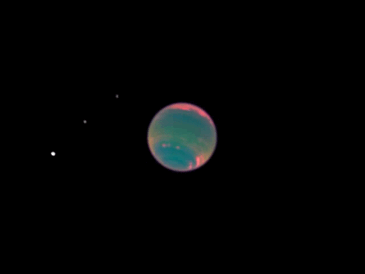Planet Uranus

Planet uranus
Credit : NASA
More Posts from Starlost and Others
space shit is cancelled until we solve homelessness and poverty

lionsinthezoo.com

Caldwell 86 by NASA Hubble
The celestial object of the day is TOI-1338b, unofficially known as Wolftopia!


This planet orbits around two stars, causing irregularities in its orbit, making it vary between 95 and 93 days. Although its orbit will keep being stable for another ten million years, its angle towards us will change, meaning that we can't see another transit until 2031.

What is a Rogue Planet?
A rogue planet (also termed a free-floating (FFP), interstellar, nomad, orphan, sunless, starless, unbound or wandering planet) is an interstellar object of planetary-mass, therefore smaller than fusors (stars and brown dwarfs) and without a host planetary system. Such objects have been ejected from the planetary system in which they formed or have never been gravitationally bound to any star or brown dwarf. The Milky Way alone may have billions to trillions of rogue planets, a range the upcoming Nancy Grace Roman Space Telescope will likely be able to narrow down.
Source
image Credit: ESO/L. Calçada/P. Delorme/R. Saito/VVV Consortium


The Newest & Clearest photo of Pluto.

![Squidolus [Day:1331 Hour:0]](https://64.media.tumblr.com/f31ac2882af7e3a9ca58a25f942f8d52/1739bd1e4c808bc3-5f/s500x750/0923c41ef5b4f230107b4a616ce97b7f168c7f0a.png)
Squidolus [Day:1331 Hour:0]

Neptune and its moons (Proteus, Larissa, Despina and Galatea)
Credit: NASA / Hubble (infrared)
-
 carlottaragazzaloveeur reblogged this · 1 month ago
carlottaragazzaloveeur reblogged this · 1 month ago -
 carlottaragazzaloveeur liked this · 1 month ago
carlottaragazzaloveeur liked this · 1 month ago -
 junian5522 liked this · 2 months ago
junian5522 liked this · 2 months ago -
 severescissorszonkdean liked this · 1 year ago
severescissorszonkdean liked this · 1 year ago -
 mp-64 liked this · 1 year ago
mp-64 liked this · 1 year ago -
 ziojinx liked this · 2 years ago
ziojinx liked this · 2 years ago -
 justlyitsjustme reblogged this · 2 years ago
justlyitsjustme reblogged this · 2 years ago -
 soonamisapphire reblogged this · 2 years ago
soonamisapphire reblogged this · 2 years ago -
 soonamisapphire liked this · 2 years ago
soonamisapphire liked this · 2 years ago -
 hobbes60 liked this · 2 years ago
hobbes60 liked this · 2 years ago -
 k-llewellin-novelist reblogged this · 2 years ago
k-llewellin-novelist reblogged this · 2 years ago -
 k-llewellin-novelist liked this · 2 years ago
k-llewellin-novelist liked this · 2 years ago -
 starlost reblogged this · 2 years ago
starlost reblogged this · 2 years ago -
 caveforstuff liked this · 2 years ago
caveforstuff liked this · 2 years ago -
 gamerram liked this · 3 years ago
gamerram liked this · 3 years ago -
 7nci-his liked this · 3 years ago
7nci-his liked this · 3 years ago -
 robthewriter reblogged this · 3 years ago
robthewriter reblogged this · 3 years ago -
 robthewriter liked this · 3 years ago
robthewriter liked this · 3 years ago -
 fred-leforgeur-baudelaire liked this · 3 years ago
fred-leforgeur-baudelaire liked this · 3 years ago -
 ludovico-sblog-uomo liked this · 3 years ago
ludovico-sblog-uomo liked this · 3 years ago -
 miritiroconleggerezza reblogged this · 3 years ago
miritiroconleggerezza reblogged this · 3 years ago -
 miritiroconleggerezza liked this · 3 years ago
miritiroconleggerezza liked this · 3 years ago -
 connors-conjurations liked this · 3 years ago
connors-conjurations liked this · 3 years ago -
 cernunnos1990 reblogged this · 3 years ago
cernunnos1990 reblogged this · 3 years ago -
 cernunnos1990 liked this · 3 years ago
cernunnos1990 liked this · 3 years ago -
 metronn liked this · 3 years ago
metronn liked this · 3 years ago -
 lord-tigeron liked this · 3 years ago
lord-tigeron liked this · 3 years ago -
 virgovil reblogged this · 3 years ago
virgovil reblogged this · 3 years ago -
 virgovil liked this · 3 years ago
virgovil liked this · 3 years ago -
 monkiiluv liked this · 3 years ago
monkiiluv liked this · 3 years ago -
 dianlyx liked this · 3 years ago
dianlyx liked this · 3 years ago -
 thechangeling13 liked this · 3 years ago
thechangeling13 liked this · 3 years ago -
 ttstach liked this · 3 years ago
ttstach liked this · 3 years ago -
 boann-of-the-river liked this · 3 years ago
boann-of-the-river liked this · 3 years ago -
 ali-almusawy liked this · 3 years ago
ali-almusawy liked this · 3 years ago -
 thelostdreamsthings liked this · 3 years ago
thelostdreamsthings liked this · 3 years ago -
 wolf-88blog liked this · 3 years ago
wolf-88blog liked this · 3 years ago

andrei, he/him, 21, made this at 14 when i was a space nerd but i never fully grew out of that phase so,,,,..,hubble telescope + alien life + exoplanet + sci fi nerd
245 posts